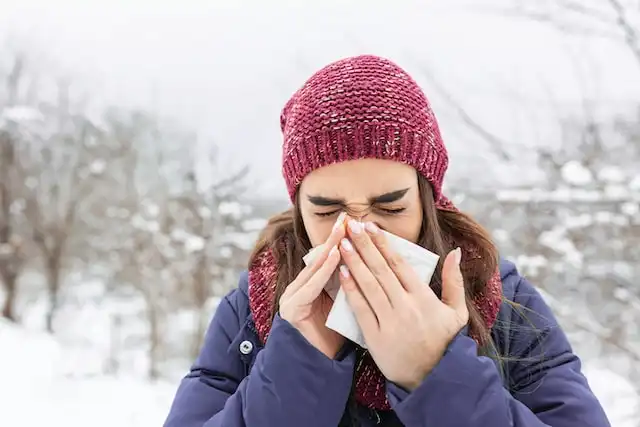What is postnasal drip?
Postnasal drip is excessive secretion of mucus that travels down the back of your throat. Your throat might feel itchy or irritated, and you might constantly feel the need to clear it. Postnasal drip can cause a chronic cough if not addressed properly.
What are the causes of postnasal drip?
Possible causes of postnasal drip include:
- cold or flu
- hay fever
- sinusitis
- cold or dry air
- eating spicy foods
- inhaling smoke, chemicals, and other irritants
- pregnancy
- certain medications
- acid reflux
- chronic respiratory conditions
What are the symptoms of postnasal drip?
Chronic cough and runny nose are the two most common symptoms of postnasal drip. Other symptoms include scratchy or painful throat, foul breath, nausea, stuffy nose, and hoarseness of voice. Since mucus is more prone to trickle down the throat while lying down, coughing caused by postnasal drip might be more severe at night.
How do I know if it's postnasal drip or COVID-19?
While coughing, nasal congestion, and scratchy throat are common symptoms of both conditions, COVID-19 causes more severe symptoms including fever, exhaustion, loss of smell or taste, muscle aches, and shortness of breath. If in doubt, you should take an at-home COVID test.
What are the treatment options for postnasal drip?
Depending on the cause, there are many postnasal drip therapy options. If you suspect your symptoms are the result of seasonal allergies or hay fever, finding out what you are allergic to and avoiding it is the first step. To relieve residual symptoms or if your postnasal drip is caused by an illness, the following over-the-counter and prescription drugs can help:
- Nasal steroid sprays: Intranasal steroids are the first option to treat postnasal drip. They lessen nasal inflammation and reduce mucus production. Examples of OTC steroid nasal sprays include budesonide (Rhinocort Allergy), fluticasone propionate (Flonase), and triamcinolone (Nasacort Allergy). Prescription nasal sprays include beclomethasone (Beconase), ciclesonide (Omnaris), and mometasone (Nasonex). * Oral antihistamine: Histamine, a molecule that stimulates allergy responses, is blocked by antihistamine medications. Antihistamines reduce postnasal drip by lowering nasal membrane edema (swelling) and congestion. Both first- and second-generation antihistamines are effective, but second-generation antihistamines are preferred because first-generation antihistamines have greater adverse effects and can thicken mucus rather than decrease it. First-generation antihistamines include Diphenhydramine (Benedryl), chlorpheniramine, and cyproheptadine. Desloratadine (Clarinex), loratadine (Claritin), fexofenadine (Allegra), cetirizine (Zyrtec), and levocetirizine (Xyzal) are examples of second-generation antihistamines.
- Oral decongestants: These drugs constrict the blood vessels in the nasal canal to reduce nasal congestion. Pseudoephedrine (Sudafed) is an oral decongestant that can be used alone or in combination with an antihistamine like loratadine/pseudoephedrine (Claritin-D) or fexofenadine/pseudoephedrine (Allegra-D). If you have high blood pressure, see your healthcare professional before taking oral decongestants because they can increase your blood pressure.
- Non-steroid nasal sprays: Non-steroid nasal sprays typically contain an antihistamine, an anticholinergic, or a nasal decongestant. They function by lessening the production of mucus and constricting the blood vessels in the nose. Examples include azelastine (Astelin), ipratropium (Atrovent), and oxymetazoline (Afrin). Be aware that these are not recommended for prolonged use as that can actually worsen congestion over time.
- Nasal saline drops: These are saline solutions used to irrigate the nose to relieve postnasal drip symptoms. You can buy nasal saline drops at pharmacies or make your own at home by using dissolving 3 heaping teaspoons of salt and a pinch of baking soda in 2 cups of boiled or purified water. Store in an airtight container at room temperature for up to 3 days.
- Oral leukotriene inhibitors: Leukotriene inhibitors are anti-inflammatory agents that effectively reduce the inflammation of nasal passages. They are prescribed if the patient does not respond well to other drugs. Examples include Montelukast (Singulair) and zafirlukast (Accolate).
How can I stop postnasal drip without medications?
You can help relieve your postnasal drip symptoms using the following alone or in combination with medications:
- Use a humidifier to keep the air moist.
- Drink plenty of water to thin mucus.
- Elevate your head while you sleep.
When should I seek medical intervention for postnasal drip?
Contact your doctor if your postnasal drip symptoms do not go away after 1-2 weeks of using the remedies above. There may be a more serious underlying cause that should be treated.
How can I save money on medications for postnasal drip?
With an RxLess discount coupon, you can save up to 88% on your medications. Whether or not you have health insurance, you can use RxLess coupons at most pharmacies, including CVS, Rite Aid, and Walgreens.

















